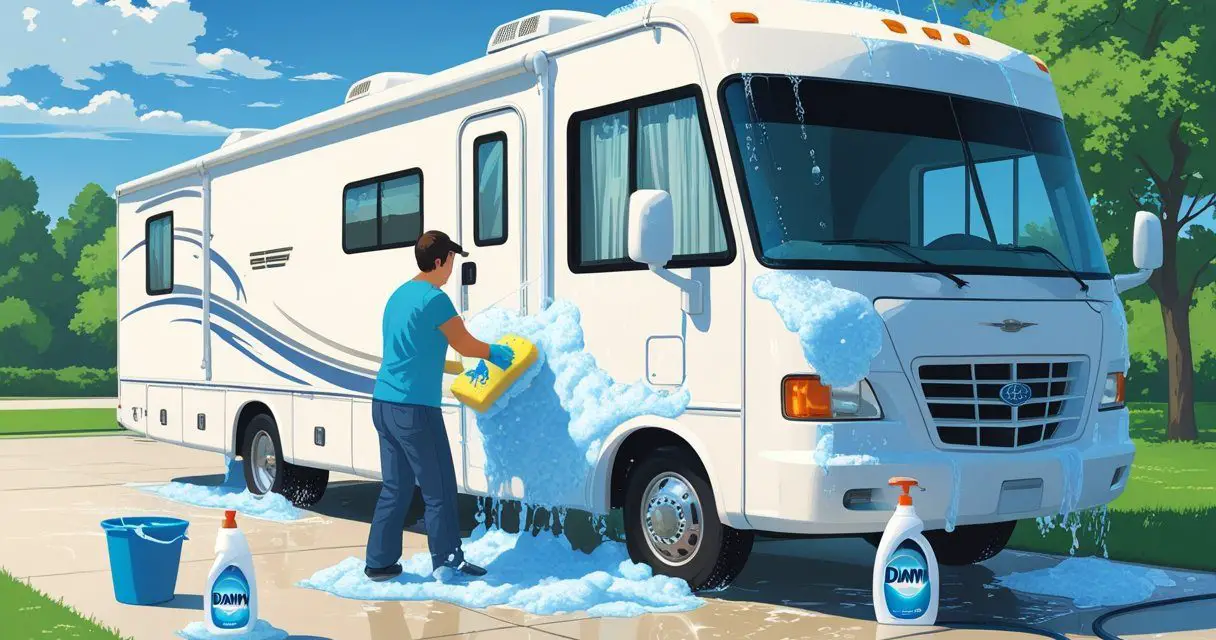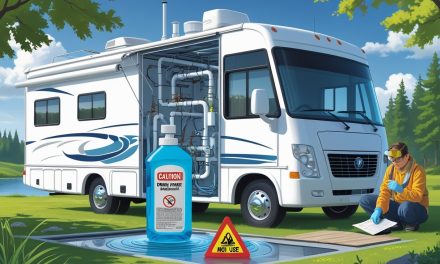Would you like to save this article?
Washing your RV seems simple, but the products you choose can make a big difference. Dawn dish soap is a common go-to because it cuts grease and is gentle on many surfaces.
You can use Dawn on your RV, but it may strip wax or protective coatings on the exterior if you use it often.
That doesn’t mean you have to avoid it completely. Dawn works well in certain areas, like cleaning the roof, windows, or even helping inside with sinks and tanks.
The key is knowing when it’s safe to use and when a cleaner made for RV surfaces is the better choice.
Key Takeaways
- Dawn can be used on RVs but may remove wax or coatings.
- It works well in specific areas like roofs, tanks, and interiors.
- Choosing the right tools and cleaners helps protect your RV long-term.
Is It Safe to Wash Your RV with Dawn Dish Soap?
Dawn dish soap can help remove grease, dirt, and even tree sap, but it also has the potential to strip protective layers from your RV. How it affects your surfaces depends on the material, finish, and how often you use it.
Potential Effects on RV Surfaces
Dawn dish soap is designed to cut through grease, which makes it effective but also strong. When used on RV exteriors, it may remove not only dirt but also protective coatings.
This can leave behind a dull film or reduce the longevity of sealants. Rubber RV roofs, like EPDM or TPO, are especially sensitive to harsh or petroleum-based cleaners.
While Dawn does not contain petroleum distillates, frequent use may dry out rubber surfaces over time. Cleaning with mild, RV-safe products is often safer for long-term roof maintenance.
For fiberglass exteriors, Dawn can clean effectively but may reduce the shine if used repeatedly. Fiberglass relies on a protective gel coat, and aggressive cleaning can wear it down.
Always rinse thoroughly to prevent soap residue from drying on the surface.
Impact on Paint, Graphics, and Wax
Painted surfaces and decals require extra care. Dawn dish soap can strip wax layers that protect your paint from UV rays and weather.
Without wax, your RV’s finish may fade faster and become more prone to oxidation. Graphics and vinyl decals are also at risk.
The grease-cutting agents in dish soap may cause edges to peel or weaken adhesive over time. This is especially true if the decals are older or exposed to direct sunlight.
If you use Dawn on painted or graphic areas, apply it sparingly and rinse well. Consider reapplying wax after washing to restore protection.
Using a cleaner formulated for RV exteriors is a better option if you want to keep your paint and decals in good condition.
Manufacturer Recommendations
RV manufacturers generally recommend using cleaners made specifically for RV exteriors. These products are formulated to be safe for fiberglass, aluminum, paint, and decals without stripping protective coatings.
Using Dawn dish soap is rarely listed as an approved method. Some owner’s manuals warn against abrasive or high-alkaline cleaners, which can damage surfaces.
While Dawn is not abrasive, it still falls outside the scope of what most manufacturers suggest. Before using dish soap, check your manual or contact the dealer for guidance.
Testing a small, hidden area first can help you see if Dawn leaves residue or affects the finish. Following manufacturer advice will help you avoid costly repairs and preserve your RV’s appearance.
How to Properly Wash Your RV Exterior with Dawn Dish Soap
When you use Dawn dish soap on your RV, the key is to control the mixture, rinse carefully, and pay attention to sensitive parts like awnings and windows. Done correctly, it can help with regular RV maintenance without leaving behind residue or stripping protective coatings.
Dilution and Application Techniques
Always dilute Dawn dish soap before applying it to your RV’s exterior. A safe ratio is about one tablespoon of Dawn per gallon of water.
This keeps the solution mild enough to clean dirt and grease without removing wax or damaging decals. Use a soft sponge, microfiber cloth, or long-handled brush to spread the soapy water.
Avoid abrasive pads, which can scratch fiberglass or painted surfaces. Work in small sections so the soap does not dry before you rinse.
If you want to reduce streaking, wash from the top down. This allows the soapy water to run off evenly and helps prevent black streaks from forming later.
Best Practices for Rinsing
Rinsing is just as important as washing. Any leftover soap can leave a film on the RV’s surface.
Use a steady stream of clean water from a hose rather than a high-pressure washer, which can damage seals, decals, and caulking. Start rinsing at the roof and move downward.
This ensures dirt and soap flow off instead of drying in place. Take extra time around edges, seams, and window frames where soap tends to collect.
If water spots are a concern, dry the surface with a soft microfiber towel or a rubber squeegee. This step helps maintain the finish and reduces streaking on darker paint or glossy fiberglass.
Cleaning Awnings and Windows
Awnings often collect mildew, tree sap, and dirt. Mix a slightly stronger Dawn solution, apply it with a spray bottle or soft brush, and let it sit for 5–10 minutes before rinsing.
Always allow the awning to dry completely before rolling it back up to prevent mold growth. For windows, use a light dilution of Dawn with warm water.
Apply with a microfiber cloth, then rinse thoroughly. Avoid using abrasive scrubbers that can scratch glass or plastic.
To finish, dry the windows with a lint-free cloth for a clear, streak-free surface. This keeps visibility sharp and prevents water spots from forming.
Using Dawn Dish Soap Inside Your RV
Dawn dish soap can help you manage everyday cleaning tasks inside your RV. It works well on greasy kitchen surfaces, bathroom fixtures, and even certain fabric stains when used carefully.
Kitchen and Bathroom Cleaning
You can use Dawn dish soap to clean sinks, counters, and stovetops. Its grease-cutting ability makes it effective for removing cooking residue without leaving harsh chemical odors.
Mix just a few drops with warm water in a spray bottle for quick wipe-downs. For your bathroom, Dawn works on shower walls, faucets, and toilets.
It can break down soap scum and grime without damaging finishes. Use a soft sponge or cloth rather than abrasive pads to avoid scratching plastic or fiberglass surfaces.
A simple cleaning mix is:
| Item | Amount | Use |
|---|---|---|
| Dawn dish soap | 2-3 drops | General cleaning |
| Warm water | 16 oz | Dilution base |
| Spray bottle | 1 | Easy application |
This mild solution is safe for most surfaces, but always rinse thoroughly to prevent soap film.
Carpet and Upholstery Stain Removal
Stains on RV carpets and upholstery can be treated with a diluted Dawn solution. Combine a small amount of dish soap with warm water, then apply it to the stain using a clean cloth.
Blot instead of scrubbing to avoid pushing the stain deeper into fabric fibers. For tougher spots like food or drink spills, let the solution sit for a few minutes before blotting.
Follow up by rinsing with a damp cloth and patting dry. Leaving soap residue can attract dirt, so rinsing is essential.
You can also mix Dawn with white vinegar for added cleaning strength. This combination helps with odors and discoloration, especially on fabric seating areas.
Always test on a hidden area first to make sure the material won’t fade.
Dawn Dish Soap in RV Black and Grey Water Tanks
Using Dawn dish soap in RV black and grey water tanks can help with cleaning, odor control, and keeping waste from sticking to the tank walls. It is not a replacement for all tank cleaners, but it offers a simple, low-cost option that many RV owners use as part of their maintenance routine.
Benefits for Black Tank Maintenance
Dawn dish soap works as a mild cleaner that helps break down grease and waste in RV black tanks. When mixed with water, it coats the inside walls of the tank and keeps solids from sticking.
This makes dumping the tank easier and reduces buildup over time. Another advantage is odor control.
Waste that clings to the tank creates unpleasant smells, but Dawn helps loosen and wash that away. Because it is biodegradable, you can use it without worrying about harming the environment when dumping your tanks.
Compared to harsher chemicals, Dawn is gentle on plumbing and seals. You don’t need large amounts—about 2–4 tablespoons or a small squeeze is usually enough.
Using too much can cause excess suds, which may interfere with tank sensors or create foam when driving.
Cleaning Procedures for Water Tanks
When cleaning your RV black tank, first dump and flush it with fresh water. Afterward, add a small amount of Dawn dish soap through the toilet along with several gallons of water.
This mixture helps clean the tank as you drive, since the motion sloshes the soapy water around. For grey water tanks, you can pour Dawn directly down the sink or shower drain.
This helps cut grease, food particles, and soap scum that often build up in grey tanks. Adding water afterward ensures the soap spreads throughout the system.
You should avoid filling the tank with too much soap. A small amount used regularly is more effective than overloading the tank once.
Always keep at least 10% of the tank filled with water after dumping to prevent waste from hardening at the bottom.
Comparing Dawn to Other Tank Cleaners
Commercial tank cleaners often use enzymes or bacteria to break down waste. These products are designed specifically for RV black tanks and may provide better long-term waste digestion.
However, they can be more expensive and harder to find than Dawn. Homemade tank cleaners, such as vinegar or baking soda, are also common.
Vinegar helps with odor and mineral buildup, while baking soda can reduce smells without adding suds. These options are inexpensive but may not clean as thoroughly as Dawn.
Dawn stands out because it is affordable, easy to find, and safe for both black and grey tanks. While it doesn’t replace enzyme-based treatments, it works well as a simple cleaner you can use between deeper cleanings.
Many RV owners combine Dawn with other methods for the best results.
Essential Tools and Accessories for RV Cleaning
Keeping your RV clean goes beyond washing the exterior. To protect your system and avoid costly repairs, you need the right tools for maintaining your tanks and waste lines.
Proper rinsing and safe disposal methods make the job easier and more sanitary.
Tank Rinser and Flush Valve Usage
A tank rinser helps remove buildup inside your black and gray tanks. Over time, waste and paper can stick to the walls, causing odors and clogs.
Using a rinser with a rotating spray head ensures water reaches all sides of the tank. A flush valve connects directly to your sewer outlet and allows you to backflush the tanks.
This pushes water in the opposite direction of normal flow, helping clear blockages. Many RVers install permanent flush valves for convenience, while others use portable versions.
When using these tools:
- Always connect a dedicated hose, not your fresh water line.
- Run the rinser until the water flows clear.
- Sanitize the hose after use to prevent contamination.
These steps keep your tanks cleaner, reduce odors, and extend the life of your plumbing system.
Sewer Hose and Macerator Tips
A sewer hose is essential for emptying your tanks. Choose a heavy-duty hose with reinforced walls to avoid leaks.
Look for clear elbow fittings so you can see when the tank is fully drained. Keep a set of disposable gloves and rinse the hose after every use.
A macerator pump grinds waste into a slurry, making it easier to pump through smaller hoses or uphill to a sewer connection. This tool is especially useful when dumping at home or in places without a direct gravity feed.
Key tips:
- Use a 12V macerator for portability.
- Avoid running the pump dry, as it can burn out the motor.
- Flush with clean water after each dump to prevent buildup.
Together, a reliable sewer hose and macerator give you more flexibility and control when managing waste disposal.
Environmental Considerations and Alternatives
When you wash your RV, the products you choose can affect both the vehicle’s finish and the environment. Using the right soap helps protect water sources, campground grounds, and your RV’s protective coatings.
Biodegradable Soaps and Eco-Friendly Practices
If you camp in areas with limited drainage, using biodegradable soap reduces the risk of harming plants and waterways. Unlike stronger detergents, these soaps break down more quickly and leave fewer residues behind.
Many campgrounds require eco-friendly cleaning solutions. Some even prohibit harsh chemicals near wash areas.
Always check local rules before you begin cleaning.
To reduce runoff, wash your RV on gravel or grass instead of pavement. This allows the ground to filter the water naturally.
Use a bucket and sponge rather than spraying large amounts of water.
When cleaning black or gray tanks, avoid pouring in excess dish soap. While small amounts of Dawn are safe, too much can cause buildup.
Tank cleaners designed for RV use are a better long-term solution since they break down waste without leaving residue.
Choosing the Right Cleaner for Your RV
Different RV surfaces need different cleaners. For painted exteriors, decals, or fiberglass, a mild RV wash or a product like Simple Green is safer than dish soap.
Dawn can strip wax or sealant, which shortens the life of protective coatings.
For rubber roofs, avoid petroleum-based or citrus cleaners that can damage the membrane. Instead, use cleaners labeled safe for EPDM or TPO materials.
If you want a single option for most surfaces, look for non-toxic, biodegradable RV soaps. These are designed to remove dirt and grime without leaving films or damaging finishes.
You can also keep a small table of uses in mind:
| Cleaner Type | Best Use | Avoid On |
|---|---|---|
| Dawn Dish Soap | Grease, sap spots | Waxed surfaces, decals |
| RV Wash Soap | General exterior | None if labeled safe |
| Tank Cleaners | Black/gray tanks | Exterior surfaces |





